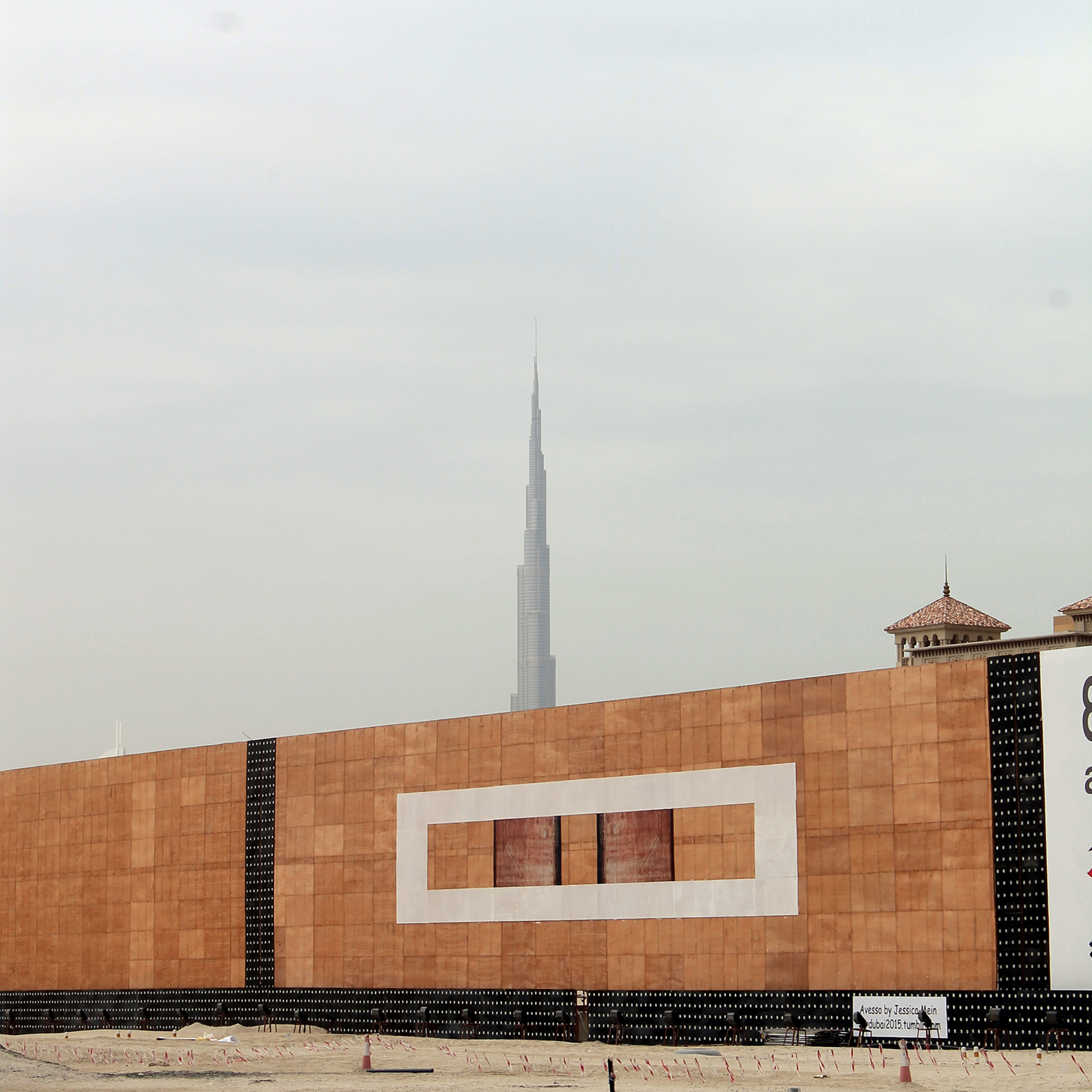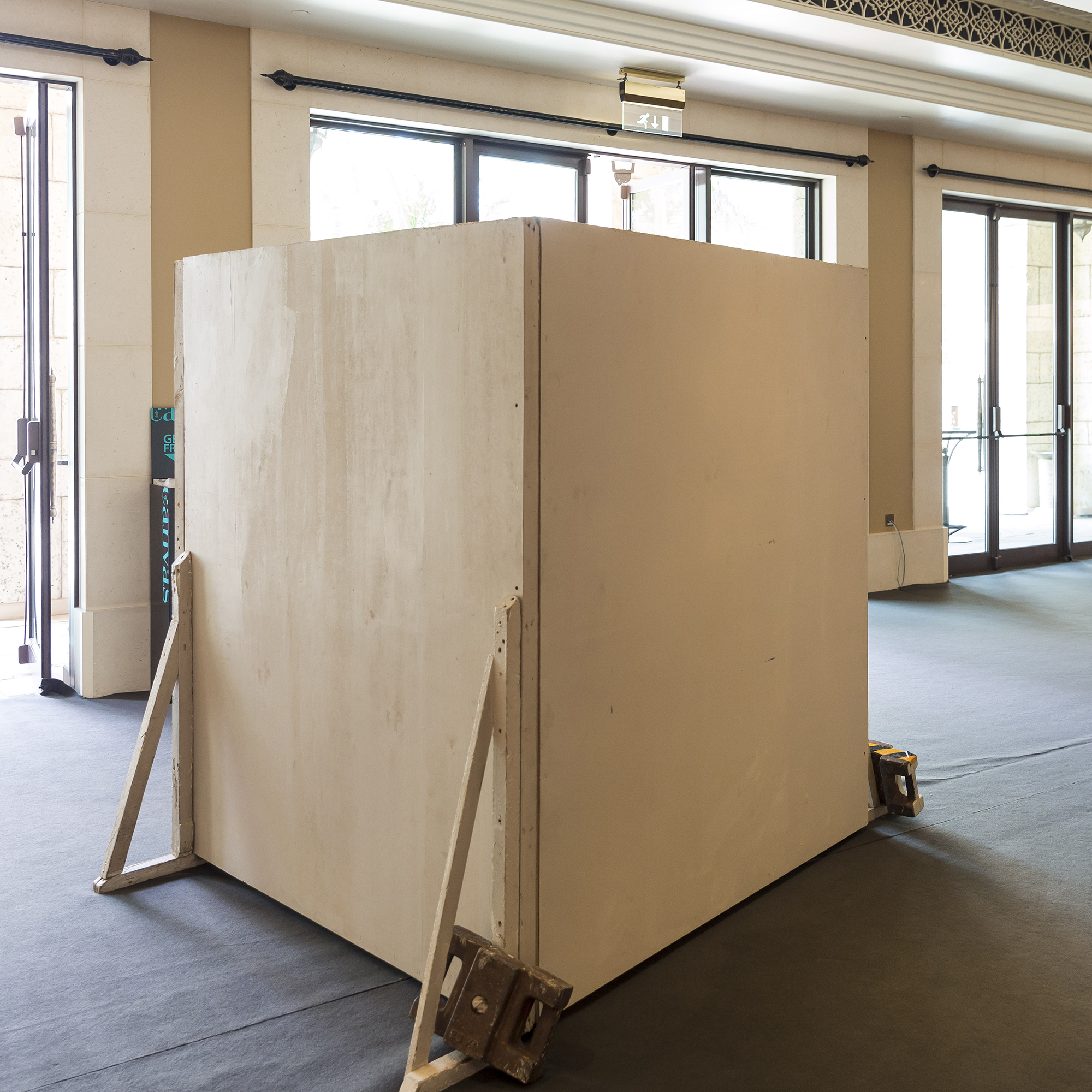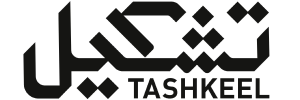Avesso - Jessica Mein
21 June 2015


Three installations using discarded building materials as a primary source material, Jessica Mein produced works that engaged with both the site of the fair as well as the city of Dubai. Avesso, an intervention on a billboard on Al Khail Road invoked questions about infrastructures and their surfaces, while the artwork under the same title at Madinat Jumeirah responded to the context of both the hotel and Art Dubai. For this installation, Mein re-purposed four dilapidated hoarding panels used by the hotel during preparation for events. Safety First was a construction fence built to block part of the scenic view of the creek between Madinat Jumeirah and Mina A'Salam hotel.
Jessica Mein was born in 1975 in São Paulo, Brazil. She received her MFA from Hunter College and currently lives and works in Dubai. Solo exhibitions include Simon Preston, New York, Galeria Leme, São Paulo, The Pavilion Downtown, Dubai. She has also exhibited as part of The Julia Stoschek Foundation, Dusseldorf and Wellin Museum, Hamilton College, New York
_________________________________________________________________________________________________________________
Lara Khaldi: You have been working for a few years now on intervening on billboards, what triggered your interest in billboards? Does it have to do with the 2006 ban on billboard advertising in São Paulo? And how is the context different here in Dubai?
Jessica Mein: I was first drawn to the precarious billboards in São Paulo as a site for a video, as I wanted to record the act of building an image in a rectangular structure using paper as a reflection of how I make my animations; with the physicality and modulation of images and paper. The animation coincided with the time that the mayor of São Paulo practically banned this type of billboards as part of “Clean City Law”. I ended up going to a satellite city/neighborhood on the cusp of São Paulo and filmed a laborer ascending and descending a ladder as he pasted sheets to an advertising hoarding. In cutting and splicing thousands of images together, the film re-animates this out-moded practice. In the process of filming these increasingly obsolete paper billboards I came across several paper fragments that had been rejected due to printing errors. Using discarded billboard material as a primary source, I focused on its printing errors, glitches and folds. I constructed collages from salvaged billboard sheets punching holes and re-gluing the pixelated dots, shifting the architecture of the printed images. I expanded this intervention further by adhering the billboards to canvas or hemp. The process of transforming printed, mass- produced, graphic advertising images made me think of modernist aspirations of mechanization and the variety of glitches and errors inherent in the mechanical, the digital, and the handmade .
During the time right after the ban on outdoor advertising, the emptied out surfaces of the hoarding and the structures that held the billboards became visible. Then when the hoardings themselves were taken down, one could better see what they were covering: from the architecture to the city’s chaos, favelas, etc.
Dubai billboard hoardings have caught my eye since I moved here about five years ago. While most of them have advertisement onto them, the ones that are empty, with their exposed structures or sometimes rotting plywood look like ruins of images. It is the back of these images, and their entrails that are most interesting to me. I am thinking more and more on the value and hierarchy of production and economy of visual language, as well as the structure and supports that hold up and make up images.
LK: It’s interesting how you mention modernist aspirations materializing through mechanical reproduction. Do you see error and emphasis on error as a way of revealing the failure of the modernizing project, or perhaps emphasizing that it is only an image?
JM: Not sure, perhaps both… Only when the machine makes the mistake, it breaks the sameness of mechanical production and creates something unique. At the moment the machine makes an error it almost becomes human. The mistake highlights the surface and materiality of the image, and breaks any illusion of seamlessness.
LK: You mention the structure that holds the billboards, and attempting to expose it, why do you feel it is important to do that?
JM: I am trying to investigate the billboard as one support for a masscommunicated message and the infra-structure behind these messages. I think this specific form of communication using still/blown up images will soon become more rare, so I see these billboards as future ruins. I am mostly interested in looking behind the billboard, at what holds it together, a jittery mass of scaffolding and the precarious entrails of what is projected.
LK: For your work at Madinat Jumeirah for Art Dubai, where you rearrange the hoarding that the hotel uses usually while installing for events to form an introverted white cube, do you see a relationship between the installation and the gallery booths in the fair halls?
JM: Yes, I see it as the entrails of the white cube, closed onto itself, and not able to project and hold any image.
LK: In our discussion yesterday you mentioned that you do not want your intervention on the billboard to be a trick of the eye, and that you do not want it to propagate what the billboard already does, that you want it to rather reveal, what exactly does the billboard camouflage, or obstruct? And how do you do that?
JM: You are right – I am not interested in propagating what the billboard does, to superimpose and project images onto it and cover its architecture. I want the surface and the modular construction of the hoarding to be incorporated into the image. In the process of intervening with the billboard, I want to somehow make a frame around it, to create an interval in the bombardment of images around the city.
LK: You mention that Avesso is closed onto itself so that it can’t hold any image, but doesn’t it really hold an artwork? Your work? How do you negotiate this, because you emphasize its failure at holding an image but reintroduce the image of failure by using it...
JM: Of course whatever I put on the billboard, no matter how abstract, will become an image in itself but it is also this tension/contradiction that interests me. The physical handling of the image and its abstraction is at the core of my work. I want this piece to block its image-making process and open up a new possibility that speaks to the structure, surface and support.
LK: What you say makes me think of iconoclasm, which is the destruction of one image in order to replace it with another, in your case it is an abstract image, or perhaps it’s an attempt at not replacing at all, rather an image of the destruction of the image as such?
JM: I think Iconoclasm is a bit too strong, at least in terms of the idea of being against visual representation for a religious or political purpose. My interest in abstraction is almost a total zooming into the image to its building block, to a point where it’s unrecognizable or it nearly loses its representational property.I like to investigate the ruptures and porousness between source material and the images they produce.
LK: It seems of course that visual art cannot even compete with advertising, which has adopted very similar strategies. How do you see your work -especially that it’s sandwiched between two huge boards with advertising on them- in this context?
JM: As you know, my original plan was to work with a billboard that is in derelict condition and is more of a ruin than a possibility for any projection of images. I ended up getting a billboard very much in use and sandwiched between three huge others with advertising on them. And that becomes very interesting in a different way, because the work is also an interruption; it breaks the logic of the three other advertising boards.
LK: You mention that you are interested in surfaces, why is that? What is a surface for you? Perhaps here the question is in relation to the construction fences that you also install at Madinat Jumeirah during Dubai Art Fair. What are you hoping that Safety First will provoke in the viewer in relation to the city?
JM: Safety First on a more literal level reflects not only Dubai’s constant construction sites but the obstruction of our view of the water. Our view here is constantly interrupted by these flat visual blocks that are the promise of a future infrastructure. The fences block the access and sight of water and any form of public gathering. On a formal level these construction fences create an interesting precarious geometry of interruption in the city. Surface is what holds the image but when made evident it has the potential to show the fragility of its architecture and the precariousness of image as a malleable skin. Here the image of a ready-made abstract board substitutes the view of depth of the water.
LK: Interesting what you say about infrastructure, as these surfaces (whether advertisement billboards, or branded construction panels) project a promise of infrastructure while the physicality of their own support is very fragile and they are always used to block the view of the actual support system of the city, whether the work force, or the barren landscape…What do you think?
JM: Exactly. They are surfaces that project the possibility of a dream of consumption or a future construction but once its skin is removed, the chaos and the fragility of its support become evident.
